Genome-wide characterization of human L1 antisense promoter-driven transcripts
- PMID: 27301971
- PMCID: PMC4908685
- DOI: 10.1186/s12864-016-2800-5
Genome-wide characterization of human L1 antisense promoter-driven transcripts
Abstract
Background: Long INterspersed Element-1 (LINE-1 or L1) is the only autonomously active, transposable element in the human genome. L1 sequences comprise approximately 17 % of the human genome, but only the evolutionarily recent, human-specific subfamily is retrotransposition competent. The L1 promoter has a bidirectional orientation containing a sense promoter that drives the transcription of two proteins required for retrotransposition and an antisense promoter. The L1 antisense promoter can drive transcription of chimeric transcripts: 5' L1 antisense sequences spliced to the exons of neighboring genes.
Results: The impact of L1 antisense promoter activity on cellular transcriptomes is poorly understood. To investigate this, we analyzed GenBank ESTs for messenger RNAs that initiate in the L1 antisense promoter. We identified 988 putative L1 antisense chimeric transcripts, 911 of which have not been previously reported. These appear to be alternative genic transcripts, sense-oriented with respect to gene and initiating near, but typically downstream of, the gene transcriptional start site. In multiple cell lines, L1 antisense promoters display enrichment for YY1 transcription factor and histone modifications associated with active promoters. Global run-on sequencing data support the activity of the L1 antisense promoter. We independently detected 124 L1 antisense chimeric transcripts using long read Pacific Biosciences RNA-seq data. Furthermore, we validated four chimeric transcripts by quantitative RT-PCR and Sanger sequencing and demonstrated that they are readily detectable in many normal human tissues.
Conclusions: We present a comprehensive characterization of human L1 antisense promoter-driven transcripts and provide substantial evidence that they are transcribed in a variety of human cell-types. Our findings reveal a new wide-reaching aspect of L1 biology by identifying antisense transcripts affecting as many as 4 % of all human genes.
Keywords: Antisense promoter; Chimeric transcript; EST; L1; LINE-1; PacBio; Retrotransposon; Transposon; YY1.
Figures
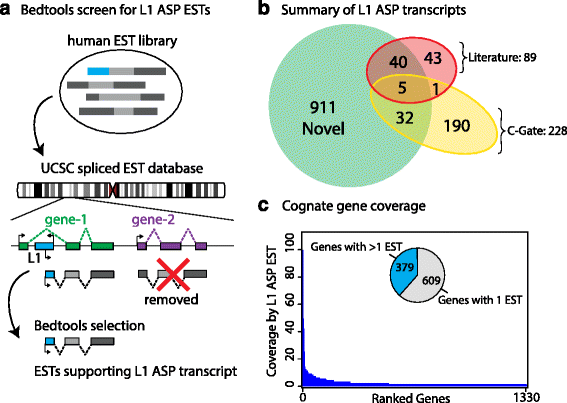
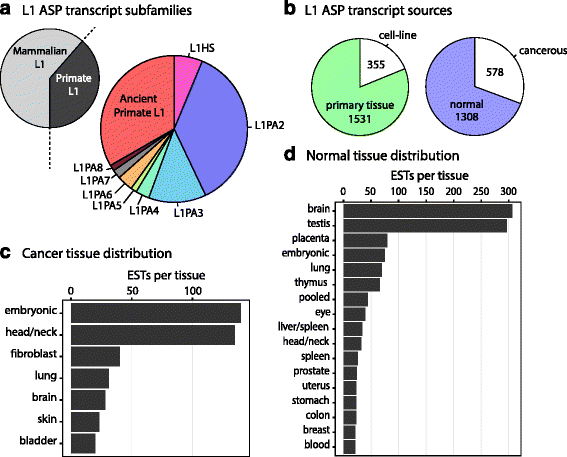
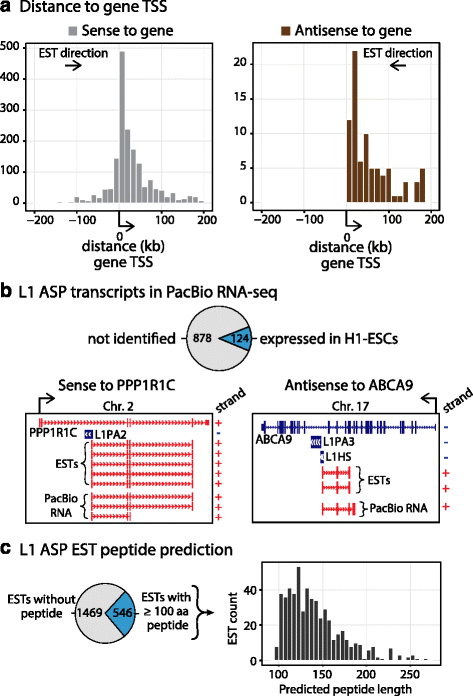

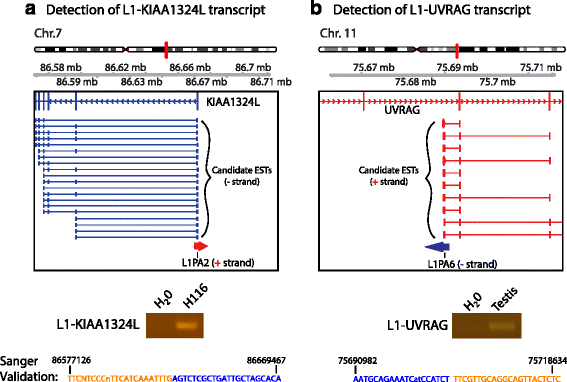
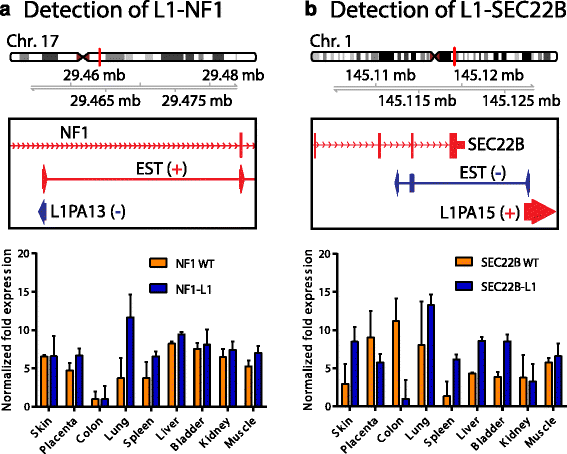
Similar articles
-
Establishment of a genome-wide and quantitative protocol for assessment of transcriptional activity at human retrotransposon L1 antisense promoters.Genes Genet Syst. 2018 Apr 10;92(5):243-249. doi: 10.1266/ggs.16-00053. Epub 2017 Apr 3. Genes Genet Syst. 2018. PMID: 28381655
-
Many human genes are transcribed from the antisense promoter of L1 retrotransposon.Genomics. 2002 May;79(5):628-34. doi: 10.1006/geno.2002.6758. Genomics. 2002. PMID: 11991712
-
Antisense promoter of human L1 retrotransposon drives transcription of adjacent cellular genes.Mol Cell Biol. 2001 Mar;21(6):1973-85. doi: 10.1128/MCB.21.6.1973-1985.2001. Mol Cell Biol. 2001. PMID: 11238933 Free PMC article.
-
Economy of Effort or Sophisticated Programming? The Prevalence of Bidirectional Promoter Complexes in the Human Genome.Genes (Basel). 2024 Feb 18;15(2):252. doi: 10.3390/genes15020252. Genes (Basel). 2024. PMID: 38397241 Free PMC article. Review.
-
The Role of Somatic L1 Retrotransposition in Human Cancers.Viruses. 2017 May 31;9(6):131. doi: 10.3390/v9060131. Viruses. 2017. PMID: 28561751 Free PMC article. Review.
Cited by
-
An intronic LINE-1 regulates IFNAR1 expression in human immune cells.Mob DNA. 2023 Nov 30;14(1):20. doi: 10.1186/s13100-023-00308-3. Mob DNA. 2023. PMID: 38037122 Free PMC article.
-
LINE1 are spliced in non-canonical transcript variants to regulate T cell quiescence and exhaustion.Nat Genet. 2022 Feb;54(2):180-193. doi: 10.1038/s41588-021-00989-7. Epub 2022 Jan 17. Nat Genet. 2022. PMID: 35039641
-
Unbiased proteomic mapping of the LINE-1 promoter using CRISPR Cas9.Mob DNA. 2021 Aug 23;12(1):21. doi: 10.1186/s13100-021-00249-9. Mob DNA. 2021. PMID: 34425899 Free PMC article.
-
Endogenous retroviral promoter exaptation in human cancer.Mob DNA. 2016 Dec 1;7:24. doi: 10.1186/s13100-016-0080-x. eCollection 2016. Mob DNA. 2016. PMID: 27980689 Free PMC article. Review.
-
Transposable elements in cancer.Nat Rev Cancer. 2017 Jul;17(7):415-424. doi: 10.1038/nrc.2017.35. Epub 2017 Jun 9. Nat Rev Cancer. 2017. PMID: 28642606 Review.
References
-
- Brouha B, Schustak J, Badge RM, Lutz-Prigge S, Farley AH, Moran JV, Kazazian HH., Jr Hot L1s account for the bulk of retrotransposition in the human population. Proceedings of the National Academy of Sciences of the United States of America. 2003;100:5280–5285. doi: 10.1073/pnas.0831042100. - DOI - PMC - PubMed
Publication types
MeSH terms
Substances
Grants and funding
LinkOut - more resources
Full Text Sources
Other Literature Sources
Research Materials

